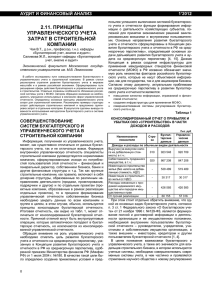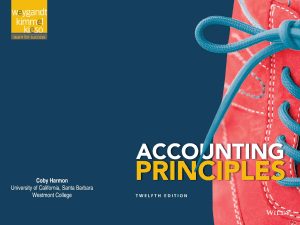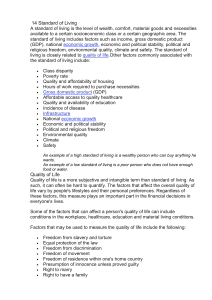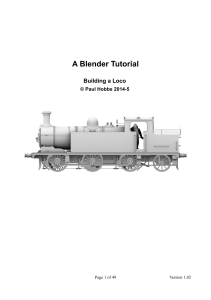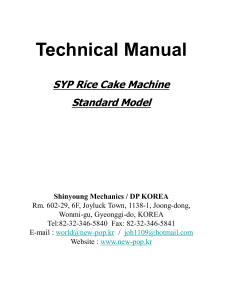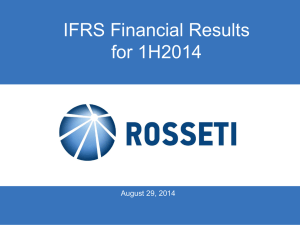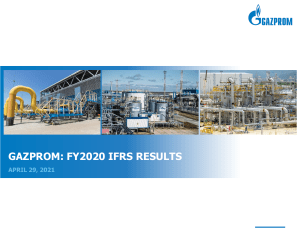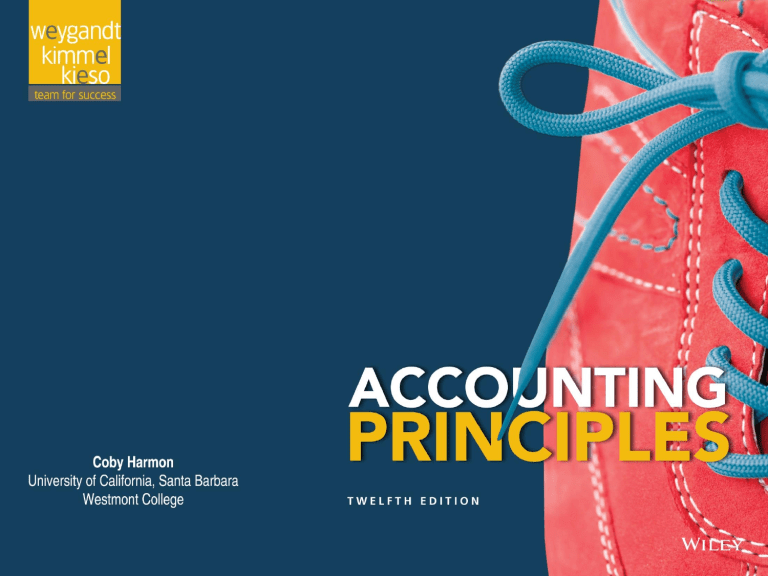
3-1 3 Adjusting The Accounts Learning Objectives 3-2 1 Explain the accrual basis of accounting and the reasons for adjusting entries. 2 Prepare adjusting entries for deferrals. 3 Prepare adjusting entries for accruals. 4 Describe the nature and purpose of an adjusted trial balance. LEARNING OBJECTIVE 1 Explain the accrual basis of accounting and the reasons for adjusting entries. Accountants divide the economic life of a business into artificial time periods (Time Period Assumption). Jan. Feb. Generally a 3-3 month, quarter, or year. Mar. Apr. ..... Dec. Alternative Terminology The time period assumption is also called the periodicity assumption. LO 1 Fiscal and Calendar Years Monthly and quarterly time periods are called interim periods. Most large companies must prepare both quarterly and annual financial statements. Fiscal Year = Accounting time period that is one year in length. 3-4 Calendar Year = January 1 to December 31. LO 1 Fiscal and Calendar Years Question The time period assumption states that: a. revenue should be recognized in the accounting period in which it is earned. b. expenses should be matched with revenues. c. the economic life of a business can be divided into artificial time periods. d. the fiscal year should correspond with the calendar year. 3-5 LO 1 Accrual- versus Cash-Basis Accounting Accrual-Basis Accounting Transactions recorded in the periods in which the events occur. Companies recognize revenues when they perform services (rather than when they receive cash). Expenses are recognized when incurred (rather than when paid). In accordance with generally accepted accounting principles (GAAP). 3-6 LO 1 Accrual- versus Cash-Basis Accounting Cash-Basis Accounting Revenues recognized when cash is received. Expenses recognized when cash is paid. Cash-basis accounting is not in accordance with generally accepted accounting principles (GAAP). 3-7 LO 1 Recognizing Revenues and Expenses REVENUE RECOGNITION PRINCIPLE Recognize revenue in the accounting period in which the performance obligation is satisfied. 3-8 LO 1 Recognizing Revenues and Expenses EXPENSE RECOGNITION PRINCIPLE Match expenses with revenues in the period when the company makes efforts that generate those revenues. “Let the expenses follow the revenues.” 3-9 LO 1 Illustration 3-1 GAAP relationships in revenue and expense recognition 3-10 LO 1 Recognizing Revenues and Expenses Question One of the following statements about the accrual basis of accounting is false? That statement is: a. Events that change a company’s financial statements are recorded in the periods in which the events occur. b. Revenue is recognized in the period in which the performance obligation is satisfied. c. The accrual basis of accounting is in accord with generally accepted accounting principles. d. Revenue is recorded only when cash is received, and expenses are recorded only when cash is paid. 3-11 LO 1 3-12 LO 1 The Need for Adjusting Entries Adjusting Entries 3-13 Ensure that the revenue recognition and expense recognition principles are followed. Necessary because the trial balance may not contain upto-date and complete data. Required every time a company prepares financial statements. Will include one income statement account and one balance sheet account. LO 1 The Need for Adjusting Entries Question Adjusting entries are made to ensure that: a. expenses are recognized in the period in which they are incurred. b. revenues are recorded in the period in which services are performed. c. balance sheet and income statement accounts have correct balances at the end of an accounting period. d. all of the above. 3-14 LO 1 Types of Adjusting Entries Illustration 3-2 Categories of adjusting entries Deferrals Accruals 1. Prepaid Expenses. Expenses 1. Accrued Revenues. paid in cash before they are used or consumed. 2. Unearned Revenues. Cash received before services are performed. 3-15 Revenues for services performed but not yet received in cash or recorded. 2. Accrued Expenses. Expenses incurred but not yet paid in cash or recorded. LO 1 Types of Adjusting Entries Trial Balance – Each account is analyzed to determine whether it is complete and up-to-date. 3-16 Illustration 3-3 LO 1 DO IT! 1 Timing Concepts A list of concepts is provided in the left column below, with a description of the concept in the right column below. There are more descriptions provided than concepts. Match the description of the concept to the concept. f Accrual-basis accounting. 1. ___ (a) Monthly and quarterly time periods. e Calendar year. 2. ___ (b) Efforts (expenses) should be matched with results (revenues). c Time period assumption. 3. ___ 4. ___ b Expense recognition principle. (c) Accountants divide the economic life of a business into artificial time periods. (d) Companies record revenues when they receive cash and record expenses when they pay out cash. (e) An accounting time period that starts on January 1 and ends on December 31. (f) 3-17 Companies record transactions in the period in which the events occur. LO 1 LEARNING OBJECTIVE 2 Prepare adjusting entries for deferrals. Deferrals are expenses or revenues that are recognized at a date later than the point when cash was originally exchanged. There are two types: 3-18 Prepaid expenses Unearned revenues LO 2 Prepaid Expenses Payment of cash, that is recorded as an asset to show the service or benefit the company will receive in the future. Cash Payment BEFORE Expense Recorded Prepayments often occur in regard to: 3-19 insurance rent supplies equipment advertising buildings LO 2 Prepaid Expenses Expire either with the passage of time or through use. Adjusting entry: ► Increase (debit) to an expense account and ► Decrease (credit) to an asset account. Illustration 3-4 3-20 LO 2 Supplies Illustration: Pioneer Advertising purchased supplies costing $2,500 on October 5. Pioneer recorded the payment by increasing (debiting) the asset Supplies. This account shows a balance of $2,500 in the October 31 trial balance. An inventory count at the close of business on October 31 reveals that $1,000 of supplies are still on hand. Oct. 31 Supplies Expense Supplies 3-21 1,500 1,500 LO 2 Supplies Illustration 3-5 3-22 LO 2 Insurance Illustration: On October 4, Pioneer Advertising paid $600 for a one-year fire insurance policy. Coverage began on October 1. Pioneer recorded the payment by increasing (debiting) Prepaid Insurance. This account shows a balance of $600 in the October 31 trial balance. Insurance of $50 ($600 ÷ 12) expires each month. Oct. 31 Insurance Expense Prepaid Insurance 3-23 50 50 LO 2 Insurance Illustration 3-6 3-24 LO 2 Depreciation Buildings, equipment, and motor vehicles (assets that provide service for many years) are recorded as assets, rather than an expense, on the date acquired. Depreciation is the process of allocating the cost of an asset to expense over its useful life. Depreciation does not attempt to report the actual change in the value of the asset. ► 3-25 Allocation concept, not a valuation concept. LO 2 Depreciation Illustration: For Pioneer Advertising, assume that depreciation on the equipment is $480 a year, or $40 per month. Oct. 31 Depreciation expense 40 Accumulated depreciation 40 Accumulated Depreciation is called a contra asset account. 3-26 LO 2 Illustration 3-7 3-27 LO 2 Depreciation STATEMENT PRESENTATION Accumulated Depreciation is a contra asset account (credit). Offsets related asset account on the balance sheet. Book value is the difference between the cost of any depreciable asset and its accumulated depreciation. Illustration 3-8 3-28 LO 2 Prepaid Expenses Summary of the accounting for prepaid expenses. Illustration 3-9 Accounting for prepaid expenses 3-29 LO 2 Unearned Revenues Receipt of cash that is recorded as a liability because the service has not been performed. Cash Receipt BEFORE Revenue Recorded Unearned revenues often occur in regard to: 3-30 Rent Magazine subscriptions Airline tickets Customer deposits LO 2 Unearned Revenues Adjusting entry is made to record the revenue for services performed during the period and to show the liability that remains at the end of the period. Results in a decrease (debit) to a liability account and an increase (credit) to a revenue account. Illustration 3-10 3-31 LO 2 Unearned Revenues Illustration: Pioneer Advertising received $1,200 on October 2 from R. Knox for advertising services expected to be completed by December 31. Unearned Service Revenue shows a balance of $1,200 in the October 31 trial balance. Analysis reveals that the company performed $400 of services in October. Oct. 31 Unearned Service Revenue Service Revenue 3-32 400 400 LO 2 Unearned Revenues Illustration 3-11 3-33 LO 2 Unearned Revenues Summary of the accounting for unearned revenues. Illustration 3-12 3-34 LO 2 3-35 LO 2 DO IT! 2 Adjusting Entries for Deferrals The ledger of Hammond Company, on March 31, 2017, includes these selected accounts before adjusting entries are prepared. Debit Prepaid Insurance Supplies Equipment Accumulated Depreciation—Equipment Unearned Service Revenue $ 3,600 2,800 25,000 Credit $5,000 9,200 An analysis of the accounts shows the following. 1. 2. 3. 4. Insurance expires at the rate of $100 per month. Supplies on hand total $800. The equipment depreciates $200 a month. During March, services were performed for one-half of the unearned service revenue. Prepare the adjusting entries for the month of March. 3-36 LO 2 DO IT! 2 Adjusting Entries for Deferrals The ledger of Hammond Company, on March 31, 2017, includes these selected accounts before adjusting entries are prepared. Debit Prepaid Insurance Supplies Equipment Accumulated Depreciation—Equipment Unearned Service Revenue $ 3,600 2,800 25,000 Credit $5,000 9,200 Prepare the adjusting entries for the month of March. 1. Insurance expires at the rate of $100 per month. Insurance Expense Prepaid Insurance 3-37 100 100 LO 2 DO IT! 2 Adjusting Entries for Deferrals The ledger of Hammond Company, on March 31, 2017, includes these selected accounts before adjusting entries are prepared. Debit Prepaid Insurance Supplies Equipment Accumulated Depreciation—Equipment Unearned Service Revenue $ 3,600 2,800 25,000 Credit $5,000 9,200 Prepare the adjusting entries for the month of March. 2. Supplies on hand total $800. Supplies Expense Supplies 3-38 2,000 2,000 LO 2 DO IT! 2 Adjusting Entries for Deferrals The ledger of Hammond Company, on March 31, 2017, includes these selected accounts before adjusting entries are prepared. Debit Prepaid Insurance Supplies Equipment Accumulated Depreciation—Equipment Unearned Service Revenue $ 3,600 2,800 25,000 Credit $5,000 9,200 Prepare the adjusting entries for the month of March. 3. The equipment depreciates $200 a month. Depreciation Expense Accumulated Depreciation—Equipment 3-39 200 200 LO 2 DO IT! 2 Adjusting Entries for Deferrals The ledger of Hammond Company, on March 31, 2017, includes these selected accounts before adjusting entries are prepared. Debit Prepaid Insurance Supplies Equipment Accumulated Depreciation—Equipment Unearned Service Revenue $ 3,600 2,800 25,000 Credit $5,000 9,200 Prepare the adjusting entries for the month of March. 4. During March, services were performed for one-half of the unearned service revenue. Unearned Service Revenue Service Revenue 3-40 4,600 4,600 LO 2 LEARNING OBJECTIVE 3 Prepare adjusting entries for accruals. Accruals are made to record 3-41 Revenues for services performed but not yet recorded at the statement date. Expenses incurred but not yet paid or recorded at the statement date. LO 3 Accrued Revenues Revenues for services performed but not yet received in cash or recorded. Revenue Recorded BEFORE Cash Receipt Accrued revenues often occur in regard to: 3-42 Rent Interest Services LO 3 Accrued Revenues Adjusting entry shows the receivable that exists and records the revenues for services performed. Adjusting entry: ► Increases (debits) an asset account and ► Increases (credits) a revenue account. Illustration 3-13 3-43 LO 3 Accrued Revenues Illustration: In October Pioneer Advertising performed services worth $200 that were not billed to clients on or before October 31. Oct. 31 Accounts Receivable 200 Service Revenue 200 On November 10, Pioneer receives cash of $200 for the services performed. Nov. 10 Cash Accounts Receivable 3-44 200 200 LO 3 Accrued Revenues Illustration 3-14 3-45 LO 3 Accrued Revenues Summary of the accounting for accrued revenues. Illustration 3-15 3-46 LO 3 Accrued Expenses Expenses incurred but not yet paid in cash or recorded. Expense Recorded BEFORE Cash Payment Accrued expenses often occur in regard to: 3-47 Rent Taxes Interest Salaries LO 3 Accrued Expenses Adjusting entry records the obligation and recognizes the expense. Adjusting entry: ► Increase (debit) an expense account and ► Increase (credit) a liability account. Illustration 3-16 3-48 LO 3 Accrued Expenses ACCRUED INTEREST Illustration: Pioneer Advertising signed a three-month note payable in the amount of $5,000 on October 1. The note requires Pioneer to pay interest at an annual rate of 12%. Illustration 3-17 Oct. 31 Interest expense Interest payable 3-49 50 50 LO 3 Accrued Expenses Illustration 3-18 3-50 LO 3 Accrued Expenses ACCRUED INTEREST Illustration: Pioneer Advertising paid salaries and wages on October 26; the next payment of salaries will not occur until November 9. The employees receive total salaries of $2,000 for a five-day work week, or $400 per day. Illustration 3-19 3-51 LO 3 Accrued Expenses Illustration 3-20 3-52 LO 3 Accrued Expenses Summary of the accounting for accrued expenses. Illustration 3-21 3-53 LO 3 3-54 LO 3 Summary of Basic Relationships Illustration 3-22 3-55 LO 3 DO IT! 3 Adjusting Entries for Accruals Micro Computer Services began operations on August 1, 2017. At the end of August 2017, management prepares monthly financial statements. The following information relates to August. 1. At August 31, the company owed its employees $800 in salaries and wages that will be paid on September 1. 2. On August 1, the company borrowed $30,000 from a local bank on a 15-year mortgage. The annual interest rate is 10%. 3. Revenue for services performed but unrecorded for August totaled $1,100. Prepare the adjusting entries needed at August 31, 2017. 3-56 LO 3 DO IT! 3 Adjusting Entries for Accruals Prepare the adjusting entries needed at August 31, 2017. 1. At August 31, the company owed its employees $800 in salaries and wages that will be paid on September 1. Salaries and Wages Expense Salaries and Wages Payable 800 800 2. On August 1, the company borrowed $30,000 from a local bank on a 15-year mortgage. The annual interest rate is 10%. Interest Expense Interest Payable 250 250 3. Revenue for services performed but unrecorded for August totaled $1,100. Accounts Receivable Service Revenue 3-57 1,100 1,100 LO 3 LEARNING OBJECTIVE 4 Describe the nature and purpose of an adjusted trial balance. Adjusted Trial Balance 3-58 Prepared after all adjusting entries are journalized and posted. Purpose is to prove the equality of debit balances and credit balances in the ledger. Is the primary basis for the preparation of financial statements. LO 4 Illustration 3-25 3-59 LO 4 Adjusted Trial Balance Question Which of the following statements is incorrect concerning the adjusted trial balance? a. An adjusted trial balance proves the equality of the total debit balances and the total credit balances in the ledger after all adjustments are made. b. The adjusted trial balance provides the primary basis for the preparation of financial statements. c. The adjusted trial balance lists the account balances segregated by assets and liabilities. d. The adjusted trial balance is prepared after the adjusting entries have been journalized and posted. 3-60 LO 4 Preparing Financial Statements Financial Statements are prepared directly from the Adjusted Trial Balance. Income Statement 3-61 Owner’s Equity Statement Balance Sheet LO 4 Illustration 3-26 Preparation of the income statement and owner’s equity statement from the adjusted trial balance 3-62 Illustration 3-27 Preparation of the balance sheet from the adjusted trial balance 3-63 LO 4 DO IT! 3-64 4 Trial Balance (a) Determine the net income for the quarter April 1 to June 30. (b) Determine the total assets and total liabilities at June 30, 2017, for Skolnick Co. (c) Determine the amount of owner’s capital at June 30, 2017. LO 4 DO IT! 3-65 4 Trial Balance LO 4 DO IT! 3-66 4 Trial Balance LO 4 DO IT! 3-67 4 Trial Balance LO 4 LEARNING OBJECTIVE 5 APPENDIX 3A: Prepare adjusting entries for the alternative treatment of deferrals. Alternate Treatment for Adjusting Entries 1. When a company prepays an expense, it debits that amount to an expense account. 2. When it receives payment for future services, it credits the amount to a revenue account. 3-68 LO 5 Prepaid Expenses Company may choose to debit (increase) an expense account rather than an asset account. This alternative treatment is simply more convenient. Illustration 3A-2 3-69 LO 5 Unearned Revenues Company may credit (increase) a revenue account when they receive cash for future services. Illustration 3A-5 3-70 LO 5 Summary of Additional Adjustments Relationships Illustration 3A-7 3-71 LO 5 LEARNING OBJECTIVE 6 APPENDIX 3B: Discuss financial reporting concepts. Qualities of Useful Information Two fundamental qualities, relevance and faithful representation. Relevance Make a difference in a business decision. Provides information that has predictive value and confirmatory value. Materiality is a company-specific aspect of relevance. ► An item is material when its size makes it likely to influence the decision of an investor or creditor. 3-72 LO 6 Qualities of Useful Information Two fundamental qualities, relevance and faithful representation. Faithful Representation 3-73 Information accurately depicts what really happened. Information must be ► complete (nothing important has been omitted), ► neutral (is not biased toward one position or another), and ► free from error. LO 6 Qualities of Useful Information ENHANCING QUALITIES Comparability results when different companies use the same accounting principles. Information is verifiable if independent observers, using the same methods, obtain similar results. Consistency means that a company uses the same accounting principles and methods from year to year. 3-74 Information has the quality of understandability if it is presented in a clear and concise fashion. For accounting information to have relevance, it must be timely. LO 6 Assumptions in Financial Reporting Illustration 3B-2 Monetary Unit Requires that only those things that can be expressed in money are included in the accounting records. 3-75 Economic Entity States that every economic entity can be separately identified and accounted for. LO 6 Assumptions in Financial Reporting Illustration 3B-2 3-76 Time Period Going Concern States that the life of a business can be divided into artificial time periods. The business will remain in operation for the foreseeable future. LO 6 Principles of Financial Reporting MEASUREMENT PRINCIPLES 3-77 Historical Cost Fair Value Or cost principle, dictates that companies record assets at their cost. Indicates that assets and liabilities should be reported at fair value (the price received to sell an asset or settle a liability). LO 6 Principles of Financial Reporting 3-78 Revenue Recognition Principle Expense Recognition Principle Requires that companies recognize revenue in the accounting period in which the performance obligation is satisfied. Dictates that efforts (expenses) be matched with results (revenues). Thus, expenses follow revenues. Full Disclosure Principle Requires that companies disclose all circumstances and events that would make a difference to financial statement users. LO 6 Cost Constraint Cost Constraint Accounting standard-setters weigh the cost that companies will incur to provide the information against the benefit that financial statement users will gain from having the information available. 3-79 LO 6 A Look at IFRS LEARNING OBJECTIVE 7 Compare the procedures for adjusting entries under GAAP and IFRS. Key Points Similarities 3-80 Companies applying IFRS also use accrual-basis accounting to ensure that they record transactions that change a company’s financial statements in the period in which events occur. Similar to GAAP, cash-basis accounting is not in accordance with IFRS. IFRS also divides the economic life of companies into artificial time periods. Under both GAAP and IFRS, this is referred to as the time period assumption. LO 7 A Look at IFRS Key Points Similarities 3-81 The general revenue recognition principle required by GAAP that is used in this textbook is similar to that used under IFRS. Revenue recognition fraud is a major issue in U.S. financial reporting. The same situation occurs in other countries, as evidenced by revenue recognition breakdowns at Dutch software company Baan NV, Japanese electronics giant NEC, and Dutch grocer Ahold NV. LO 7 A Look at IFRS Key Points Differences 3-82 Under IFRS, revaluation (using fair value) of items such as land and buildings is permitted. IFRS allows depreciation based on revaluation of assets, which is not permitted under GAAP. The terminology used for revenues and gains, and expenses and losses, differs somewhat between IFRS and GAAP. For example, income includes both revenues, which arise during the normal course of operating activities, and gains, which arise from activities outside of the normal sales of goods and services. The term income is not used this way under GAAP. Instead, under GAAP income refers to the net difference between revenues and expenses. LO 7 A Look at IFRS Key Points Differences 3-83 Under IFRS, expenses include both those costs incurred in the normal course of operations as well as losses that are not part of normal operations. This is in contrast to GAAP, which defines each separately. LO 7 A Look at IFRS Looking into the Future The IASB and FASB are completing a joint project on revenue recognition. The purpose of this project is to develop comprehensive guidance on when to recognize revenue. It is hoped that this approach will lead to more consistent accounting in this area. For more on this topic, see www.fasb.org/project/revenue_recognition.shtml. 3-84 LO 7 A Look at IFRS IFRS Practice IFRS: a. uses accrual accounting. b. uses cash-basis accounting. c. allows revenue to be recognized when a customer makes an order. d. requires that revenue not be recognized until cash is received. 3-85 LO 7 A Look at IFRS IFRS Practice Which of the following statements is false? a. IFRS employs the periodicity assumption. b. IFRS employs accrual accounting. c. IFRS requires that revenues and costs must be capable of being measured reliably. d. IFRS uses the cash basis of accounting. 3-86 LO 7 A Look at IFRS IFRS Practice As a result of the revenue recognition project being undertaken by the FASB and IASB: a. revenue recognition places more emphasis on when the performance obligation is satisfied. b. revenue recognition places more emphasis on when revenue is realized. c. revenue recognition places more emphasis on when expenses are incurred. d. revenue is no longer recorded unless cash has been received. 3-87 LO 7 Copyright “Copyright © 2015 John Wiley & Sons, Inc. All rights reserved. Reproduction or translation of this work beyond that permitted in Section 117 of the 1976 United States Copyright Act without the express written permission of the copyright owner is unlawful. Request for further information should be addressed to the Permissions Department, John Wiley & Sons, Inc. The purchaser may make back-up copies for his/her own use only and not for distribution or resale. The Publisher assumes no responsibility for errors, omissions, or damages, caused by the use of these programs or from the use of the information contained herein.” 3-88

